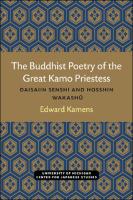The Buddhist Poetry of the Great Kamo Priestess
External Review of Whole Manuscript
Daisaiin Senshi and Hosshin Wakashu
Abstract
Senshi was born in 964 and died in 1035, in the Heian period of Japanese history (794–1185). Most of the poems discussed here are what may loosely be called Buddhist poems, since they deal with Buddhist scriptures, practices, and ideas. For this reason, most of them have been treated as examples of a category or subgenre of waka called Shakkyoka, “Buddhist poems.
Yet many Shakkyoka are more like other poems in the waka canon than they are unlike them. In the case of Senshi’s “Buddhist poems,” their language links them to the traditions of secular verse. Moreover, the poems use the essentially secular public literary language of waka to address and express serious and relatively private religious concerns and aspirations. In reading Senshi’s poems, it is as important to think about their relationship to the traditions and conventions of waka and to other waka texts as it is to think about their relationship to Buddhist thoughts, practices, and texts.
The Buddhist Poetry of the Great Kamo Priestess creates a context for the reading of Senshi’s poems by presenting what is known and what has been thought about her and them. As such, it is a vital source for any reader of Senshi and other literature of the Heian period.
Keywords
Buddhist poetryDOI
10.3998/mpub.18802ISBN
9780939512416, 9780472038312, 9780472128020, 9780472880027Publisher
University of Michigan PressPublisher website
https://www.press.umich.edu/Publication date and place
2007Series
Michigan Monograph Series in Japanese Studies, 5Classification
Society and Social Sciences
Poetry


 Download
Download Web Shop
Web Shop